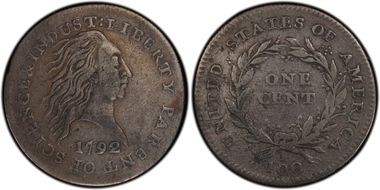1792 1C J-2, BN SP35BN 认证号29267390, PCGS号11004
专家评论
Ron Guth
1792 saw a flurry of activity aimed at establishing a Mint in America. Congress passed a Mint Act, a Director was chosen, a lot was purchased, a building was erected, and employees were hired. While the Mint Act gave directions as to which denominations were to be struck, apparently the Mint officials felt they had some discretion in choosing formats and designs.
For the One Cent piece, which was to be one of the main coins produced in 1793, four types were tested: a large copper piece (the "Birch" Cent), a smaller copper piece with a silver center (the Silver-Center Cent"), another of the same size (the Fusible Alloy Cent, in which the silver and copper were melted together), and another of the same size in pure copper. Although no written evidence remains to record the testing, clearly the large, pure copper piece was favored, as this was the chosen format when production of Large Cents began in 1793.
Judd's statement that the edges of these coins are diagonally reeded may be incorrect; all examples observed by researcher Saul Teichman have vertically reeded edges. Judd and Breen considered all the plain edge pieces to be counterfeits.
Judd 2 is the "non-Silver Center" version of Henry Voight's cent pattern. Judd 2 is known in two versions: one version made of pure copper and another version where a small amount of silver was combined with copper to create a billon alloy (sometimes referred to as "fusible alloy". The only way to tell the two versions apart is by metallurgical analysis.
Fusible Alloy examples:
Only one Fusible Alloy Cent is known. Breen claimed that the Pine Tree-ANA example had been chemically(?) tested and found to contain silver, but no silver was found in this coin when it was tested later on behalf of the cataloguer of the Norweb collection. Few of the so-called "Copper" 1792 Cents have been tested, so more "Fusible Alloy" Cents may exist.
- Harmer Rooke 11/1969 - New Jersey private collection. According to the Norweb cataloguer, this piece was tested using x-ray flourescence and found to contain silver.
Pure Copper examples:
The composition of many of the coins listed below has not been tested. Thus, some may be "Fusible Alloy" (a mixture of copper and silver) instead of being pure copper
Judd plate coin (not plated in the 7th edition)
- National Numismatic Collection at the Smithsonian Institution (called "finest" by Saul Teichman)
"EF-40"
- Lorin Parmelee, June 1890, Lot 6
- Virgil M. Brand
- B. Max Mehl, January 11, 1936
- B&M "Norweb" 11/1988:3393, "Second Finest Known, 62.2 grains, 22.4 mm, 360°", $35,200.00
PCGS VF-30
- Oliver Wolcott, Jr?
- Wolcott family
- Goldbergs 02/2005:806, sold for $437,000.00
Very Fine
- Seavey, 1873
- E. Maris, 1886, Lot 146
- T.H. Garrett
- Bowers & Ruddy's "Garrett Collection" sale, March 1981:2348, "63.1 grains", $28,000.00
PCGS VG-10
- Lauder:234 (pedigreed incorrectly there)
- Dana Linett, sold for $15,000 in 1983
- David Henderson
- Bowers and Merena "Rare Coin Review, No. 53" 10/1984, page 16
- Goldbergs "Benson Part 1" 02/2001:151, $57,500.00
- Southern Collection
- Simspon Collection
Hinman
- Paramount "Century" 04/1965:50
- Bowers & Ruddy "Rare Coin Review, No. 19", 1974, p. 17
- Bowers & Ruddy "Rare Coin Review, No. 20", 1974, p. 14
- Douglas Robins, Inc. (Coin World, December 4, 1974)
- Pine Tree 02/1975:59 (not Lot 69 as has been cited on occasion)
- American Numismatic Association
70.2 grains. The authenticity of this piece has been questioned in the past but it is believed to be authentic by Tom DeLorey and Walter Breen. Breen claimed that this piece was tested chemically and found to contain silver, but this was refuted in a later test done on behalf of the cataloguer of the Norweb collection.
- W.S. Appleton
- Massachusetts Historical Society (illustrated at Crosby Plate X - 12)
- American Numismatic Society
- Adams-Woodin plate coin
- L. R. Lohr (1961)
- Bowers & Ruddy "River Oaks" 11/1976:909
- Stack's 01/1987:476
Sources and/or recommended reading:
"United States Pattern, Experimental and Trial Pieces" by J. Hewitt Judd, M.D.
"Walter Breen's Complete Encyclopedia of United States and Colonial Coins" by Walter Breen
"United States Patterns And Related Issues" by Andrew W. Pollock III
www.uspatterns.com/j2p2.html





















